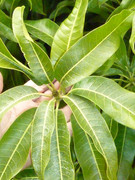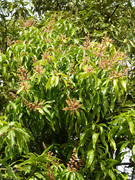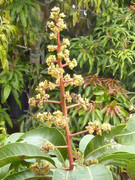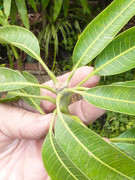JF asked for an explanation of our mango pruning techniques. This post explains the technique and we have also included some pictures to illustrate what to cut and what not to cut.
How to prune a mango tree for maximum production.
We are always looking for new ways to help our fellow mango lovers with the results of our research. We also like to share ideas with fellow plant researchers around the world. When we find something good, we always trade ideas and sometimes pick up great new things we can share with our friends through the Tropical Fruit Forum.
Here is the latest new and exciting news for mango growers, both back yard gardeners and commercial ranchers! You can keep your mango tree, any variety, to a reasonable size for hand picking and actually increase fruit production. We can do that by careful, selective pruning. Our friends in India and South Africa have been working to control the size of their mango trees. We all know that if you just let a mango tree go, it will grow to massive size. It is a little hard to pick the fruit from the top of a 40 or 50 foot tall mango tree. The solution is to train your new mango tree and maintain a maximum height of about 10 feet tall. That will allow you to pick most of the fruit by hand with only a picking pole to reach the rest at the top of the tree.
We are not talking about dwarf mango varieties! Any variety can be trained to a easily manageable height and this will also allow you to have room for a few more mango varieties in your yard if you want. Commercial growers can double or triple their fruit production per acre using the techniques we describe and that is really exciting.
We have also included some pictures to illustrate the pruning techniques we are using to maintain the mango tree size with out adversely affecting the trees fruit production. Mango trees have a unique method of growth that allows us to use careful pruning to manage the trees and it is very easy with the smaller size tree.
First there are two things to know about the mango growth. This is time of year, the mango trees are coming into bloom in Southern California. Take a careful look at the terminal mango branches in the first picture. This is the last new growth that the tree put on in the fall of 2013 as cooler weather arrived. The arrival of the Winter “chill” signals the mango plant to switch from active vegetative growth to a resting state so the tree could prepare for flowering and subsequent fruit production. DO NOT cut any of this new growth with the little conical bud tips when you start to prune your mango tree. If you cut off any of these, you will be cutting off new flowering wood and won’t get those luscious mangoes you will be expecting in 2014 growing season.

The second picture shows a mango tree in full bloom with blossom panicles distributed across the tree.

The third picture shows a close up of a blossom panicle showing the flowers.

The fourth picture shows a terminal branch that has a flat area at the end of the branch in the center of the leaf swirl. That flat area was where a blossom panicle was attached in the 2013 blooming and fruiting season. This is the branch that you can cut off without doing any damage to the tree and it’s fruit production. The trick is to cut back the branch to the beginning of the 2013 growing season’s growth. This will not affect this years fruiting at all. It will allow you to reduce the size of your mango tree and will also spur new growth that will give you fruiting blossom panicle growth for the 2015 fruiting season.
